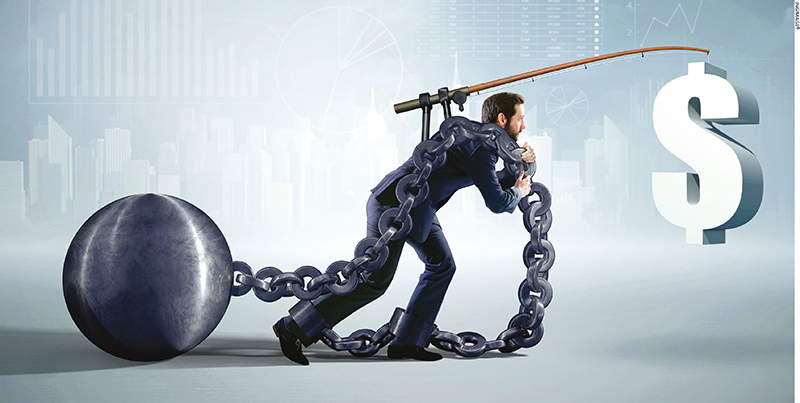DOLLAR POWER
TRANSITIONING DOLLAR?
Aaron Fernando tracks the dollar’s circular path via trade deficits and surplus recycling

As things stand, the health of every economy on Earth is dependent on one factor: flow. If money does not move, everything and everyone in that economy will begin to wither and die. It’s that simple but preventing it is notoriously complex.
Since the US Dollar is still the foremost reserve currency in the world, there’s a massive demand for it. Global demand for the greenback is far greater than for any other national currency and because of this, the United States has been allowed to overspend and maintain a consistent trade deficit since the end of World War II aka WWII.
THE TRIFFIN DILEMMA During the Bretton Woods Conference towards the end of WWII, it was agreed that nations would use the US Dollar as their reserve currency and it would be backed by gold.
Each nation’s currency would have a fixed exchange rate with the dollar – and each dollar would represent a certain quantity of gold. Yet, this posed a serious systemic problem, which was relatively unknown at the time.
Some had already realised this problem and in 1960, economist Robert Triffin testified to the US Congress on the issue and popularised the idea that would be referred to as the ‘Triffin Dilemma.’
Very simply, all nations of the world need liquidity – i.e. some means of exchange to have their economies functioning properly. And since Uncle Sam was the issuer of this global means of exchange, any economic growth would require the US to issue more dollars.
The Triffin Dilemma is the name for the reason why it is necessary for the US to constantly increase its trade deficit to ensure sufficient liquidity in the global economy. Effectively, it has faced few consequences for running a huge trade deficit since the end of WWII.
Aside from having to break from the Bretton Woods system in 1971 due to there being inadequate gold to support the currency, the US has enjoyed what is called an ‘exorbitant privilege’ for remaining the primary global reserve currency.
SURPLUS RECYCLING Shortly after the Bretton Woods Conference, US officials also realised that for the sake of the financial health of their own country, they would need to construct clever mechanisms to allow dollars to flow through other nations’ economies.
Greece’s ex-finance minister Yanis Varoufakis explains that it is necessary for strong economies to find ways to recycle money back to deficit regions – so that the powerful economic centres can earn that money again. Varoufakis has dubbed these methods of recycling money to poorer regions as ‘Surplus Recycling Mechanisms’ or SRMs.
He writes that during good times, banks act as an SRM: “The money that the surplus economies amass from selling more stuff to the deficit economies than they buy from them accumulates in their banks. But these banks are then tempted to lend much of it back to the deficit countries or regions where interest rates are always higher because money is so much scarcer.”
Varoufakis calls the banks fair weather surplus recyclers – when things are going well, banks profit from lending. Yet, when things begin to sour – e.g. when a shock runs through the global financial system – banks panic and credit tightens, resulting in a vicious cycle.
“Lax lending turns to no lending at all… Housing prices collapse, public works are abandoned, office buildings turn into ghostly towers, shops are boarded up, incomes disappear and governments announce austerity,” Varoufakis explains.
Without a way to resolve these unbalanced trade flows, the system will come to a grinding halt. And it’s a problem that occurs in any country with a single currency (in a currency union like the euro, for example) or between countries that mostly use one reserve currency.
Following World War II, the US Marshall Plan and development projects in East Asia acted as massive SRMs, turning Germany and Japan into manufacturing and financial centres that would pull in dollars and then lend them out again.
Some nation level SRMs are established politically. They’re official like Medicare, government grants, and construction and military spending. Others are semiofficial or unofficial – nonprofits transferring wealth from wealthy regions to populations in poorer regions or remittance payments across borders.
RECENT DEVELOPMENTS Though there will always be a need for SRMs to ensure economic sustainability, the dollar’s role as the foremost reserve currency is changing.
Recently, there have been significant developments that could knock the dollar off its international pedestal and eventually bring increased stability to the global economy through the diversity of reserve currencies.
On 1 September, the Nikkei Asian Review reported that China is expected to launch a crude oil futures contract priced in yuan, which is also convertible to gold. Since China is the leading oil importer in the world, this can have a major effect on the petrodollar system, allowing countries to bypass the dollar when buying and selling oil.
Not only will this reduce dollar hegemony in the region, it’ll also result in shrinking global demand for the currency that could result in domestic inflation and reduced American buying power. And almost certainly, it’ll transform the global economic landscape in profound ways.






Leave a comment